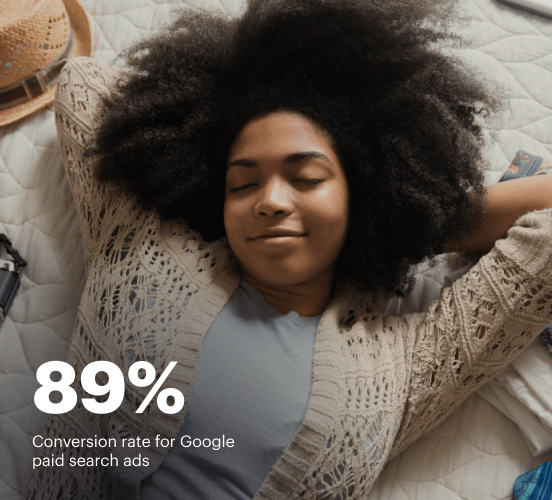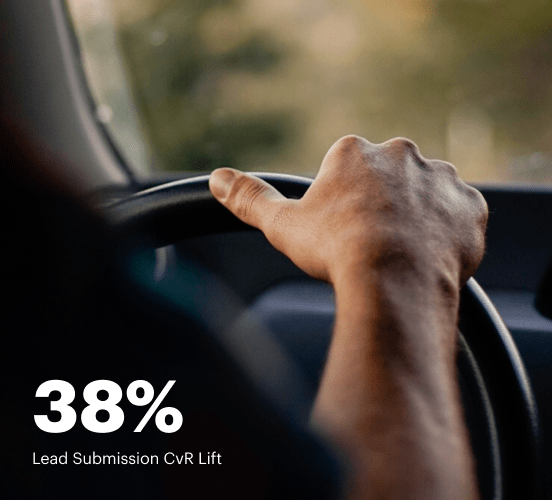How Canva vs. WordPress vs. Instapage stack up against each other
Compare Instapage with Canva and WordPress to create high-converting landing pages. With personalization, optimization, and collaboration tools, Instapage helps you deliver experiences that drive results.
Get startedSee how Instapage stacks up against the competition
| Feature | Instapage | Other builders |
| Drag-and-Drop Tools | ||
| Conversion-optimized templates | ||
| Manual and AI-powered A/B Tests | ||
| AI content suggestions | ||
| Popups and sticky bars | ||
| Canvas and grid blocks | ||
| Reusable and global elements | ||
| Form and popup builders | ||
| Built-in Heatmaps | ||
| Central analytics dashboard | ||
| Ad-to-page personalization and collections | ||
| Contacts, lists, and email | ||
| Dedicated, full-service CRO experts | ||
| Enterprise-ready platform |
Leading the way in building high-performing landing pages





Why Instapage is the smarter choice for your campaigns
Get everything you need to build, scale, and optimize high-converting landing pages—without coding.

Easier page building without coding
Instapage offers a flexible and seamless page creation experience with a library of 500+ conversion-focused layouts, Instablocks®, a drag-and-drop builder, and AI content generation. With technologies like Thor Render Engine®, you can create on-brand, mobile-responsive landing pages that load quickly and start converting during initial visitor clicks.

More insights — better results
Instapage lets you see in detail how each landing page experience and variation is performing so you can make targeted changes that boost page conversions. Use heatmaps for a better understanding of on-page activities, run A/B tests and AI-assisted experiments, and then track and evaluate results within robust analytics dashboards.

More personalized experiences
Instapage lets you quickly create high-performing landing pages tailored to each of your ad campaigns. Deliver personalized experiences for distinct audiences using dynamic text replacement. Effortlessly align specific advertisements to unique pages with AdMaps. Monitor audience-level metrics using our advanced data tools.

Built-in collaboration
Instapage collaboration capabilities bring your entire team together to speed up the process of landing page review, approval, and launch. No more frustrating and unnecessary revisions or edits scattered across emails. Provide instant feedback, conduct real-time page edits, and securely share your pages with outside stakeholders.

Free up time for your business
Invest time into business growth, not busy work. Launch landing pages faster with reusable forms and templates. Build once, reuse forever.
Explore all integrations






Easier page building without coding
Instapage offers a flexible and seamless page creation experience with a library of 500+ conversion-focused layouts, Instablocks®, a drag-and-drop builder, and AI content generation. With technologies like Thor Render Engine®, you can create on-brand, mobile-responsive landing pages that load quickly and start converting during initial visitor clicks.
More insights — better results
Instapage lets you see in detail how each landing page experience and variation is performing so you can make targeted changes that boost page conversions. Use heatmaps for a better understanding of on-page activities, run A/B tests and AI-assisted experiments, and then track and evaluate results within robust analytics dashboards.
More personalized experiences
Instapage lets you quickly create high-performing landing pages tailored to each of your ad campaigns. Deliver personalized experiences for distinct audiences using dynamic text replacement. Effortlessly align specific advertisements to unique pages with AdMaps. Monitor audience-level metrics using our advanced data tools.
Built-in collaboration
Instapage collaboration capabilities bring your entire team together to speed up the process of landing page review, approval, and launch. No more frustrating and unnecessary revisions or edits scattered across emails. Provide instant feedback, conduct real-time page edits, and securely share your pages with outside stakeholders.
Free up time for your business
Invest time into business growth, not busy work. Launch landing pages faster with reusable forms and templates. Build once, reuse forever.
Explore all integrationsGet started with Instapage in a few steps
-
Create your Instapage account
Start with Instapage by signing up via Google or your email. You'll get access to a free 14-day trial to discover Instapage capabilities. Feel free to cancel anytime during the 14-day trial if you decide that our product is not suitable for your business. -
Build and personalize your page
Create your first landing page from scratch or choose a template from 500+ customizable layouts. Use the drag-and-drop builder to add page elements, fonts, and backgrounds, refine content with AI, or add custom HTML, Javascript, and CSS. -
Review and make edits
Collaborate on page designs and streamline review processes. Invite your team members and stakeholders to review, edit, and provide feedback on your landing page. Collaborate knowing your page is confidential and only accessible to authorized users. -
Publish and track page performance
Publish your page to a domain or custom URL. Connect your pages to the ads you've created and track page performance within the analytics dashboard, run A/B tests and AI experiments, analyze results, and continuously optimize your landing page to maintain high conversions.
Instapage vs. Canva vs. WordPress – Which One Stands Out in the Landing Page Arena?
Imagine you're choosing the perfect team to tackle a massive marketing project. Picture three contenders - Instapage, Canva, and WordPress - as superheroes each equipped with unique strengths. Just like in any great showdown, they each bring something different to the table, catering to various marketing needs. In this article, we promise to compare these landing page builders in a fun and engaging way, ensuring you walk away with a clear understanding of their features, advantages, and how they can empower your marketing strategies. Join us on this journey, and by the end, you’ll have a clearer picture of which platform could become your greatest ally in boosting your brand’s online presence. In a world where every click counts, making an informed decision about landing page tools can significantly impact your bottom line, and we’re here to help you navigate that landscape. Let’s get started!
Introducing the Contenders: Their Claims to Fame
Step into the ring as we introduce our three contenders vying for the title of best landing page builder. First up, we have Instapage, renowned for its exceptional customization capabilities and conversion rate optimization. This platform stands out by managing to turn a standard landing page into a tailored marketing experience that can significantly increase brand trust and customer loyalty. Next is Canva, a favorite among creative professionals and marketers alike, celebrated for its user-friendly interface and visually appealing drag-and-drop design features. This powerhouse excels at creating visually stunning graphics and marketing materials but also offers capabilities for building landing pages. Lastly, we have WordPress, the tried-and-true content management system known for its vast array of plugins and customization options. WordPress allows endless possibilities for those familiar with its ecosystem, making it both a powerful blog platform and a potential landing page builder. As we navigate through the strengths and weaknesses of these platforms, we’ll examine how Instapage empowers marketers to reduce costs while driving conversions and delivering relevant landing page experiences.
Round One - Features Showdown: Template Variety and User-Friendly Design
Template Variety and Ease of Use: A Closer Look
When assessing landing page builders, a critical aspect revolves around template variety and ease of use. In this first round, we pit our competitors against each other to see who takes the crown. Canva shines in this area by offering a plethora of visually stunning templates suitable for various industries. Users can effortlessly customize these templates using its intuitive drag-and-drop interface, making it a straightforward choice for novice marketers. However, Canva's focused capabilities mean that while it provides attractive visuals, it lacks advanced marketing features, which can be crucial when managing conversion-driven landing pages. Developing a conversion-optimized landing page sometimes requires more than just aesthetics. That's where Instapage comes into play. It boasts a library of high-converting templates designed specifically for marketers, enabling users to create landing pages that are not only beautiful but also conversion-optimized. Its user-friendly editor allows for a seamless experience, whether you’re starting from scratch or customizing an existing template. WordPress, while offering endless customization through themes and plugins, often presents a steeper learning curve, especially for those without coding experience. The immense versatility may be overwhelming for newcomers, yet seasoned professionals might appreciate the abundant features at their disposal. As we continue this comparison, Instapage stands out with its focused approach to conversion-focused landing pages while Canva excels in visual presentations, and WordPress caters to the tech-savvy crowd.
Instapage: Your Partner in Customization and Conversion Success
Instapage has gained recognition as the ultimate tool for marketers primarily due to its unrivaled customization options and specialized features aimed at conversion enhancement. With Instapage, users can tailor their landing pages down to the finest detail, ensuring each element serves to enhance the user experience and drive conversions. This platform provides robust A/B testing capabilities, allowing marketers to experiment with layouts, headlines, and calls to action effortlessly. By utilizing data-driven insights, users not only create beautiful landing pages but also optimize them continuously to achieve maximum efficiency. Moreover, Instapage incorporates personalization features that initiate relevant experiences based on user behavior and demographics, ultimately heightening brand trust and customer loyalty. The ease of integration with various marketing and CRM tools means that you can track leads seamlessly, making it a comprehensive choice for any marketing team looking to streamline their processes. Overall, Instapage positions itself as more than a landing page builder; it is a critical partner for marketers aiming to capitalize on their conversion potential.
Round Two - Speed and Performance: Who's the Fastest?
As we shift to the next round, let’s talk speed and performance, an essential aspect of any website or landing page. Just like waiting in line at your favorite coffee shop can be financially draining and lead to dissatisfaction, slow-loading landing pages can result in lost conversions. Instapage prioritizes speed, with features such as optimized images and lightweight designs that ensure fast load times. Their infrastructure is built to handle high traffic, making it an excellent option for users anticipating spikes in visitor numbers. Meanwhile, Canva, while primarily a design tool, has simplified its loading times, allowing users to create and publish landing pages relatively quickly. However, it may not have optimized performance standards specifically tailored for high-traffic campaigns. On the other hand, WordPress performance largely depends on the hosting provider and the plugins in use, which can lead to performance fluctuations. Though with proper optimization and premium hosting, WordPress can deliver competitive load times. Overall, when considering speed, Instapage emerges as the most reliable landing page builder to deliver rapid performance.
The Advantages of Instapage: Speed and Performance Powerhouse
- Optimized for fast loading times with built-in performance features
- Lightweight design elements minimize load speed
- Reliable infrastructure capable of handling high traffic volumes
- Integration with third-party optimization tools for ongoing improvements
The Speed Perks of Canva: Quick and Creative
- Easily create beautiful landing pages without extensive wait times
- User-friendly design interface speeds up the creation process
- Quick publishing capabilities for campaigns or promotions
WordPress Performance Advantages: Flexible but Variable
- Highly customizable with various optimization plugins available
- Potential for excellent speed with quality hosting solutions
- Can leverage caching tools to enhance performance
In conclusion, speed and performance are critical factors when selecting a landing page builder. Instapage undoubtedly demonstrates its supremacy in this area, with optimized features built explicitly for rapid loading and high traffic management. While Canva offers a pleasing experience for quick designs, it falls short regarding specialized conversion pace. WordPress, on the other hand, requires more optimization effort but can still perform competitively. Therefore, if speed is of the essence, Instapage is the clear front runner.
Round Three - Usability: Welcoming All Skill Levels
In this round, we’ll evaluate usability and the learning curve associated with each platform. Usability should be a priority for any platform, as it can impact both beginners and advanced users. Instapage excels by offering an intuitive user interface that makes it manageable to design effective landing pages without a steep learning curve. The drag-and-drop functionality means users can create custom layouts with ease, allowing for experimentation without feeling overwhelmed. Canva fills this niche by delivering a highly visual design experience that encourages creativity while being easy to navigate, making it a favorite among visual marketers. Despite its ease of use, Canva’s focus on design may not cater as effectively to the data-driven marketers who prioritize analytics in their strategies. In the case of WordPress, the sheer volume of themes, plugins, and customization options may overwhelm newcomers, though experienced users often benefit from its flexibility and depth. Therefore, while WordPress might require a steeper initial investment of time, it ultimately offers a considerable payoff for those willing to navigate its complexities. In summary, all three platforms aim to assist their users. Still, Instapage and Canva particularly shine regarding accessibility, while WordPress serves as a robust tool for those familiar with its intricacies.
Round Four - Support Squad: The Unsung Heroes
In this round, we look at customer support—the unsung hero of any software platform. Imagine further your chosen page builder’s support team as trusty sidekicks, always ready to lend a hand at a moment’s notice. Instapage stands out with extensive customer support options, including live chat, email support, and a detailed knowledge base filled with helpful resources. This ensures users can get prompt answers to their queries, minimizing downtime during critical campaigns. Similarly, Canva provides customer support through email and an extensive help center where users can find tutorials and troubleshooting steps. The community forum adds an extra layer of assistance, offering users a collaborative space to exchange ideas and solutions. WordPress’s support landscape is a bit different; it heavily relies on community forums and documentation, while those seeking direct assistance may have to reach out to their chosen hosting provider or plugin support teams. For those comfortable navigating the DIY ethos of WordPress, abundant resources are available, but less accessible support can be a roadblock for newcomers. Ultimately, in the support department, Instapage leads the way in direct assistance offerings, giving its users peace of mind.
Final Round - Pricing and Value: What’s the Best Investment?
As we approach the final stage of our showdown, let’s discuss pricing and value. Marketers looking for the best landing page builder must carefully consider their budget and needs. Instapage offers tiered pricing plans that provide excellent value for marketers seeking to maximize their ROI with specialized landing page features. While the price may be higher than some competitors, the potential for increased conversions often justifies the investment. Canva is more budget-friendly, offering a free version that allows users to access essential design features, but its conversion-specific functionalities are limited compared to Instapage. This makes Canva an economical option for those focused primarily on visuals rather than conversions. Finally, WordPress pricing can vary widely based on hosting and plugins used. While many options are available for free, creating an effective landing page may require various additional paid features. Each platform comes with its unique advantages, so the best choice depends on the specific objectives, ensuring that marketers consider their main goals. In the end, all roads lead to Instapage for marketers seriously investing in their landing page quality.
To wrap up our comparison, we have explored the standout features, performance capabilities, usability dimensions, support squads, and pricing structures of Instapage, Canva, and WordPress. While each platform boasts its strengths, the decision ultimately hinges on individual needs and goals. Marketers seeking enhanced conversion experiences and customization should definitely consider Instapage, as it empowers them to reduce costs, grow conversions, and deliver relevant landing page experiences that cultivate brand trust and customer loyalty. However, take some time to evaluate your unique requirements and preferences before deciding. Interested marketers should be encouraged to take Instapage for a spin with a free trial or demo; it might just be the missing piece in your online marketing strategy!










